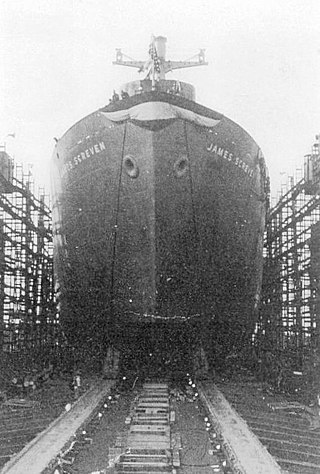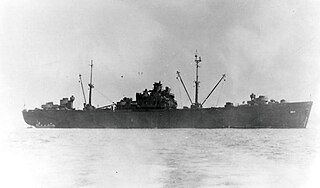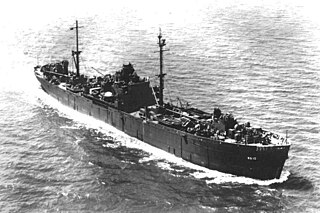
USS Leyte (ARG-8), later USS Maui (ARG-8), was a Luzon-class internal combustion engine repair ship that saw service in the United States Navy from 1944 to 1946. She was scrapped in 1972.

USS Culebra Island (ARG-7) was a Luzon-class internal combustion engine repair ship in the service of the United States Navy from 1944 to 1947. She was scrapped in 1974.

USS Appanoose (AK-226) was a Crater-class cargo ship in the United States Navy named for Appanoose County, Iowa.

USS Holland (AS-3) was a submarine tender that served in the United States Navy before and during World War II. Holland was launched by the Puget Sound Naval Shipyard, Bremerton, Washington on 12 April 1926, sponsored by Miss Elizabeth Saunders Chase, daughter of Admiral J. V. Chase, and commissioned on 1 June. Stationed at San Diego, California, tending submarine divisions there with periodic tours to Panama to service submarines based at the Canal Zone pre-World War two. Later serving in the Pacific theatre, by close of hostilities having given 55 instances of refit to submarines, provided repair and service to 20 surface craft and completed various jobs on shore installations.

USS Kermit Roosevelt (ARG-16) was a Luzon-class internal combustion engine repair ship that saw service in the United States Navy during World War II. She was the only U.S. Naval vessel to be named for Kermit Roosevelt I, the second son of President Theodore Roosevelt and a soldier who served in two world wars.

USS Mindanao (ARG-3) was a Luzon-class internal combustion engine repair ship in service with the United States Navy from 1943 to 1947. She was sunk as an artificial reef in 1980.

USS Luzon (ARG-2) was an internal combustion engine repair ship in service with the United States Navy from 1943 to 1947 and from 1950 to 1960. She was the lead ship in a class of twelve ships and was scrapped in 1974.

USS Oahu (ARG-5) was a Luzon-class internal combustion engine repair ship that saw service in the United States Navy during World War II. Named for the Island of Oahu, third largest island in the Hawaiian chain, it was the second US Naval vessel to bear the name.

USS Mona Island (ARG-9) was Luzon-class internal combustion engine repair ship in service with the United States Navy from 1944 to 1947. She was sunk as an artificial reef in 1975.

USS Shaula (AK-118) was a Crater-class cargo ship, converted from a Liberty Ship, commissioned by the US Navy for service in World War II. She was first named after James Screven, an American general during the American Revolutionary War. She was renamed and commissioned after Shaula, the second-brightest star system in the constellation of Scorpius. She was responsible for delivering troops, goods and equipment to locations in the war zone.

USS Allegan (AK-225) was a Crater-class cargo ship commissioned by the U.S. Navy for service in World War II. She was responsible for delivering troops, goods and equipment to locations in the war zone.

USS Laertes (AR-20) was a Xanthus class repair ship in the service of the United States Navy from 1945 to 1972.

The Xanthus-class repair ships were a class of five auxiliary ships built for the United States Navy and Royal Navy. Ships of the class served in a diverse range of environments in varying capacities during both World War II and the Korean War. Xanthus-class ships were in commission between 1945–1955.

USS Tutuila (ARG-4) was a Luzon-class internal combustion engine repair ship that saw service in the United States Navy during World War II, The Korean War, and The Vietnam War as well as several smaller actions. Named for the Island of Tutuila, the largest and main island of American Samoa, it was the second US Naval vessel to bear the name. After serving for nearly 30 years Tutuila was sold to the Republic of China in 1972.

USS Samar (ARG-11) was a Luzon class internal combustion engine repair ship that saw service in the United States Navy during the final days of World War II, and in the post-war period. Named for the Samar Island in the Philippines, it was the second U.S. Naval vessel to bear the name.

USS Palawan (ARG-10) was a Luzon class internal combustion engine repair ship that saw service in the United States Navy from 1945 to 1947. She was sunk as an artificial reef in 1977.

USS Chourre (ARV-1) was a Chourre-class aircraft repair ship that saw service in the United States Navy during World War II and the Korean War.

USS Hooper Island (ARG-17) was a Luzon-class repair ship designated for internal combustion engine repair in service with the United States Navy from 1945 to 1948 and from 1952 to 1959. She was sold for scrapping in 1960.
HMS LST-407 was a United States Navy LST-1-class tank landing ship that was transferred to the Royal Navy during World War II. As with many of her class, the ship was never named. Instead, she was referred to by her hull designation.
HMS LST-412 was a United States Navy LST-1-class tank landing ship that was transferred to the Royal Navy during World War II. As with many of her class, the ship was never named. Instead, she was referred to by her hull designation.
This page is based on this
Wikipedia article Text is available under the
CC BY-SA 4.0 license; additional terms may apply.
Images, videos and audio are available under their respective licenses.

![SS Francis P. Duffey [ex-USS Cebu (ARG-6)] laid up in reserve at Suisun Bay, CA., 27 July 1972. USS Cebu (ARG-6) laid up at Suisun Bay, California (USA), 27 July 1972 (NH 83859).jpg](http://upload.wikimedia.org/wikipedia/commons/thumb/e/e2/USS_Cebu_%28ARG-6%29_laid_up_at_Suisun_Bay%2C_California_%28USA%29%2C_27_July_1972_%28NH_83859%29.jpg/220px-USS_Cebu_%28ARG-6%29_laid_up_at_Suisun_Bay%2C_California_%28USA%29%2C_27_July_1972_%28NH_83859%29.jpg)

















